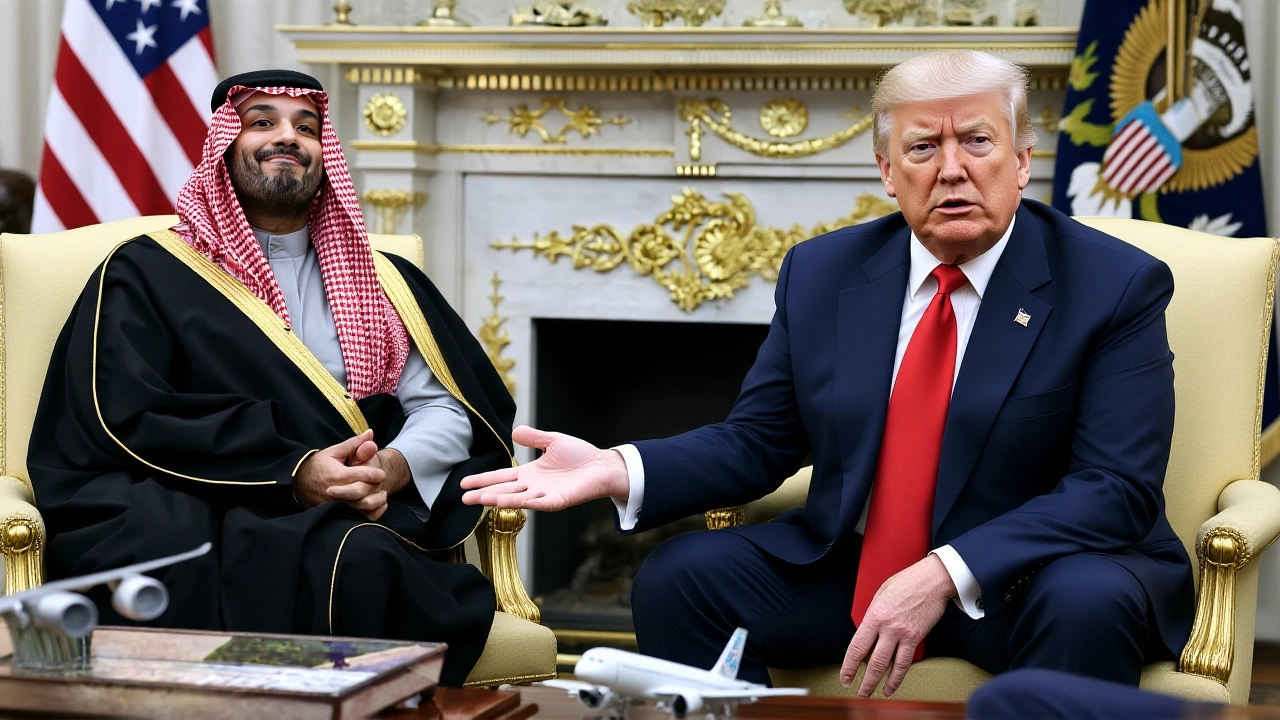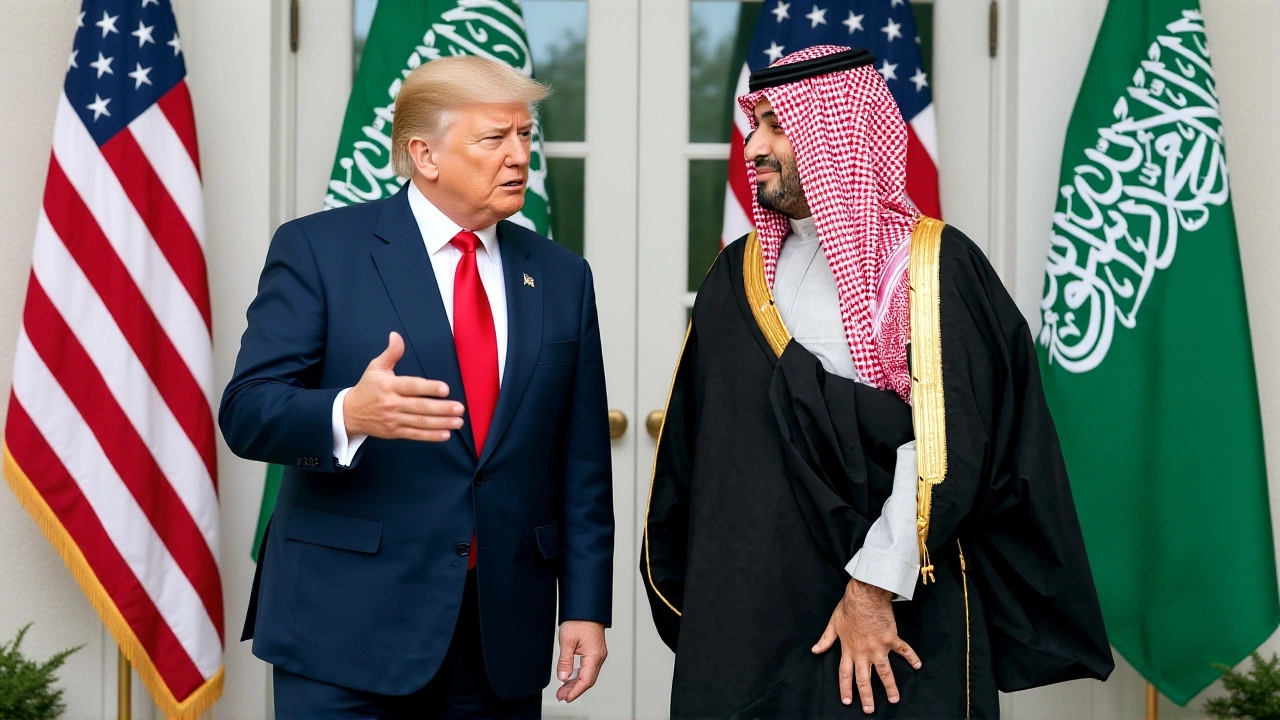On a crisp November evening in Washington, D.C., Donald J. Trump and Mohammed bin Salman Al Saud clinked wine glasses in the East Room of the White House, sealing not just a dinner—but a new chapter in U.S.-Saudi relations. The official working visitWashington, D.C. ended with a $1 trillion investment pledge, whispers of nuclear cooperation, and a quiet but powerful push to bring Saudi Arabia into the Abraham Accords framework. It wasn’t just diplomacy. It was ambition, on a scale rarely seen in modern statecraft.
From $600 Billion to $1 Trillion: The Numbers Behind the Deal
The most startling moment came during a private meeting between Trump and Crown Prince Mohammed bin Salman. When Trump asked, "So you are doing that now, you're saying to me now that the $600 billion will be $1 trillion?" the Crown Prince didn’t hesitate. "Definitely," he replied. "Because what we are signing, it will facilitate that." Trump grinned. "Good. I like that very much." That $1 trillion figure isn’t a guess. It’s the projected value of joint ventures spanning artificial intelligence infrastructure, defense systems, renewable energy grids, and critical mineral supply chains. Saudi Arabia’s Public Investment Fund, led by the Crown Prince, plans to deploy capital across U.S. tech hubs—from Austin to Pittsburgh—while American firms like Lockheed Martin and General Electric will receive long-term contracts to build Saudi industrial capacity. The deal includes a 30-year commitment to U.S. arms sales, with F-35s, missile defense systems, and cyber warfare tools topping the list.Nuclear Energy: A Quiet Revolution
While headlines focused on money, the real game-changer was civil nuclear energy. The two leaders signed a framework for U.S. technical assistance in developing Saudi Arabia’s peaceful nuclear program—a move that could reshape Middle East energy dynamics. The agreement includes training for Saudi engineers, fuel supply assurances, and a commitment to international safeguards under the IAEA. Crucially, it stops short of allowing uranium enrichment on Saudi soil, a red line Washington has held for decades. "We want to be energy independent," the Crown Prince told reporters after the lunch. "But we also want to be responsible. We don’t need to build bombs to be powerful. We need clean power to build the future." The U.S. Department of Energy confirmed that a joint working group will meet in January 2026 to finalize reactor design standards and safety protocols. This isn’t just about electricity—it’s about legitimacy. Saudi Arabia is positioning itself as a regional tech leader, and nuclear energy is its most visible symbol.Peace Between Israelis and Palestinians? The Abraham Accords Expansion
The most delicate subject was Israel. For years, Saudi Arabia has refused to normalize relations unless a Palestinian state is established. But now, the Crown Prince said something different: "We want peace for the Israelis, we want peace for the Palestinians. We want them to coexist peacefully in the region, and we will do our best... the United States of America, so we will do our best to see that day happen." That’s not a full endorsement of the Abraham Accords yet—but it’s a crack in the wall. The U.S. State Department is now quietly briefing Israeli and Palestinian negotiators on a potential "Saudi engagement track," separate from direct talks. If Riyadh joins the Accords, it would be the biggest expansion since the UAE and Bahrain signed on in 2020. It would also isolate Iran further and give Trump a foreign policy win he can tout ahead of the 2028 election.
Iran: The Elephant in the Room
Trump didn’t ignore Iran. "And by the way, Iran does want to make a deal," he said. "I can say I think they very badly want to make a deal. I am totally open to it and we're talking to them and we start a process, but it would be a nice thing..." No details were offered. But U.S. intelligence sources confirm that backchannel talks have been ongoing since September through Omani intermediaries. The Saudis, for their part, are reportedly encouraging Washington to pursue a deal—seeing it as a way to reduce regional tensions that could threaten their investments.What Comes Next? The Diplomatic Machinery Kicks In
The visit ended with a farewell ceremony on the South Lawn, where a 21-gun salute echoed over the National Mall. But the real work begins now. The White House Office of the Press Secretary and the Royal Court of Saudi Arabia in Riyadh are establishing a joint implementation task force. First meetings are scheduled for December 10, 2025. The goal: sign binding memoranda of understanding on nuclear cooperation by March 2026, and unveil the first $200 billion in investment projects by June. The U.S. Embassy in Riyadh and the Saudi Embassy in Washington are already coordinating logistics. Staff from both sides are working weekends. One senior U.S. official, speaking anonymously, said: "This isn’t a photo op. It’s a long-term restructuring of the Middle East’s economic and security architecture."
Why This Matters
This isn’t just about oil anymore. It’s about who controls the technologies of the 21st century—AI, nuclear energy, quantum computing, defense systems. Saudi Arabia, flush with petrodollars and ambitious leadership, is betting big on the U.S. as its partner. And Trump, hungry for legacy-defining achievements, is happy to oblige. The implications ripple outward. If Saudi Arabia joins the Abraham Accords, Egypt, Jordan, and even Morocco may follow. If nuclear cooperation succeeds, other Gulf states like the UAE and Qatar will demand similar deals. And if Iran enters negotiations, the entire regional balance shifts. The world watched as two men shook hands in the East Room. But behind them stood the machinery of a new alliance—one built not on ideology, but on dollars, data, and the quiet understanding that peace, when profitable, becomes possible.Frequently Asked Questions
What does the $1 trillion investment actually include?
The $1 trillion covers a mix of defense contracts (F-35s, missile systems), AI infrastructure development, renewable energy projects, and critical mineral supply chains. Saudi Arabia’s Public Investment Fund will invest in U.S. tech firms, while American companies like Lockheed Martin and General Electric will build industrial capacity in Saudi Arabia. The deal spans 10–30 years, with $200 billion in initial projects targeted for June 2026.
Will Saudi Arabia get nuclear weapons under this deal?
No. The agreement strictly limits cooperation to civil nuclear energy—power generation, medical isotopes, and research reactors—with full IAEA oversight. Uranium enrichment and plutonium reprocessing are prohibited on Saudi soil. The U.S. will supply enriched fuel under strict conditions, ensuring no weapons-grade material is produced. This mirrors the model used with the UAE in 2009.
How close is Saudi Arabia to normalizing relations with Israel?
Not yet formal, but the door is open. Crown Prince Mohammed bin Salman signaled willingness to support peace between Israelis and Palestinians, a major shift from past Saudi policy. The U.S. is now exploring a "Saudi engagement track"—separate from direct talks—to build trust. If Riyadh joins the Abraham Accords, it would be the most significant expansion since 2020 and could pressure other Arab states to follow.
Why is Trump pushing this deal now?
Trump is seeking a legacy-defining foreign policy achievement ahead of the 2028 election. A $1 trillion deal with Saudi Arabia, combined with potential progress on Iran and Israel, gives him a narrative of strength and deal-making prowess. It also counters criticism over his first term’s handling of Saudi human rights issues—by focusing on economic and strategic gains instead.
What role does Iran play in all of this?
Iran is the silent third actor. Trump mentioned ongoing backchannel talks, likely mediated by Oman. Saudi Arabia, despite its rivalry with Tehran, sees a U.S.-Iran deal as beneficial—it reduces the risk of regional conflict that could disrupt their investments. A deal could also pressure Iran to accept limits on its nuclear program in exchange for sanctions relief, aligning with U.S. and Saudi security interests.
When will we see the first results of this agreement?
The first tangible outcomes are expected by June 2026, when $200 billion in joint projects are slated to be unveiled. A joint U.S.-Saudi task force will meet in December 2025 to finalize implementation details. Nuclear cooperation agreements are targeted for March 2026, while defense contracts will begin rolling out in early 2026, with deliveries starting in 2027.
